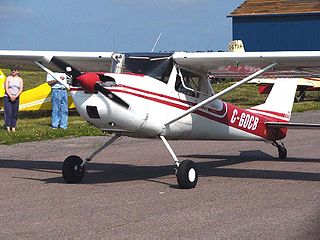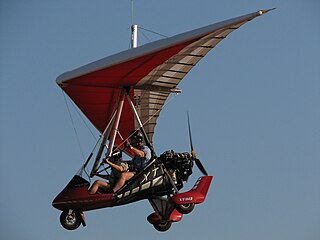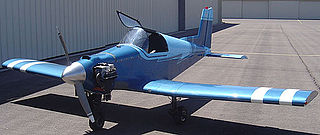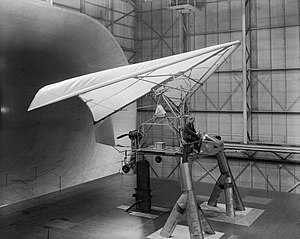
A fixed-wing aircraft is a heavier-than-air aircraft, such as an airplane, which is capable of flight using aerodynamic lift. Fixed-wing aircraft are distinct from rotary-wing aircraft, and ornithopters. The wings of a fixed-wing aircraft are not necessarily rigid; kites, hang gliders, variable-sweep wing aircraft, and airplanes that use wing morphing are all classified as fixed wing.

The Rogallo wing is a flexible type of wing. In 1948, Francis Rogallo, a NASA engineer, and his wife Gertrude Rogallo, invented a self-inflating flexible wing they called the Parawing, also known after them as the "Rogallo Wing" and flexible wing. NASA considered Rogallo's flexible wing as an alternative recovery system for the Mercury and Gemini space capsules, and for possible use in other spacecraft landings, but the idea was dropped from Gemini in 1964 in favor of conventional parachutes.

Francis Melvin Rogallo was an American aeronautical engineer inventor born in Sanger, California, U.S. Together with his wife, he is credited with the invention of the Rogallo wing, or "flexible wing", a precursor to the modern hang glider and paraglider. His patents were ranged over mechanical utility patents and ornamental design patents for wing controls, airfoils, target kite, flexible wing, and advanced configurations for flexible wing vehicles.

Landing gear is the undercarriage of an aircraft or spacecraft that is used for taxiing, takeoff or landing. For aircraft it is generally needed for both. It was also formerly called alighting gear by some manufacturers, such as the Glenn L. Martin Company. For aircraft, Stinton makes the terminology distinction undercarriage (British) = landing gear (US).

Conventional landing gear, or tailwheel-type landing gear, is an aircraft undercarriage consisting of two main wheels forward of the center of gravity and a small wheel or skid to support the tail. The term taildragger is also used.

The NASA M2-F1 is a lightweight, unpowered prototype aircraft, developed to flight-test the wingless lifting body concept. Its unusual appearance earned it the nickname "flying bathtub" and was designated the M2-F1, the M referring to "manned", and F referring to "flight" version. In 1962, NASA Dryden management approved a program to build a lightweight, unpowered lifting-body prototype. It featured a plywood shell placed over a tubular steel frame crafted at Dryden. Construction was completed in 1963.
Taras Kiceniuk Jr. is a hang glider pioneer from southern California.

A vertical stabilizer or tail fin is the static part of the vertical tail of an aircraft. The term is commonly applied to the assembly of both this fixed surface and one or more movable rudders hinged to it. Their role is to provide control, stability and trim in yaw. It is part of the aircraft empennage, specifically of its stabilizers.

An ultralight trike or paratrike is a type of powered hang glider where flight control is by weight-shift. These aircraft have a fabric flex-wing from which is suspended a tricycle fuselage pod driven by a pusher propeller. The pod accommodates either a solo pilot, or a pilot and a single passenger. Trikes grant affordable, accessible, and exciting flying, and have been popular since the 1980s.

Hang gliding is an air sport employing a foot-launchable aircraft. Typically, a modern hang glider is constructed of an aluminium alloy or composite-framed fabric wing. The pilot is ensconced in a harness suspended from the airframe, and exercises control by shifting body weight in opposition to a control frame.

The NASA Paresev was an experimental NASA glider aircraft based upon the kite-parachute studies by NASA engineer Francis Rogallo.

The Ling-Temco-Vought (LTV) XC-142 is a tiltwing experimental aircraft designed to investigate the operational suitability of vertical/short takeoff and landing (V/STOL) transports. An XC-142A first flew conventionally on 29 September 1964, and completed its first transitional flight on 11 January 1965 by taking off vertically, changing to forward flight, and finally landing vertically. Its service sponsors pulled out of the program one by one, and it eventually ended due to a lack of interest after demonstrating its capabilities successfully.
Barry Hill Palmer is an American aeronautical engineer, inventor, builder and pilot of the first hang glider based on the Rogallo wing or flexible wing. Palmer also designed, built and flew the first weight-shift ultralight trike aircraft.

The Ryan VZ-3 Vertiplane, also known by the company designation Ryan Model 92 was an American experimental vertical/short take-off (VSTOL) aircraft built by the Ryan Aeronautical Company for the United States Army.

The Parker Teenie Two is a single-seat, single-engine sport aircraft first built in the United States in 1969 and marketed for homebuilding. It is a low-wing, cantilever monoplane of conventional configuration and fixed tricycle undercarriage. The cockpit was designed to be left open, but plans for a canopy to enclose it were made available, the use of which would increase the top speed of the aircraft. The Teenie Two was specifically designed to use a converted Volkswagen automobile engine for power. The outer wing panels can be detached for transport or storage.

W. L. "Lou" Everett was a United States Army Air Corps fighter pilot and test pilot.
The Manta Foxbat is an American ultralight aircraft that was designed by Bill Armour and produced by Manta Products Inc of Oakland, California. The aircraft was supplied as a kit for amateur construction.
The Swiss Piccard Eureka was designed to be an easily transportable single seat three-axis ultralight. Its development was brought to a halt by the Swiss ban on ultralight aircraft in 1984.
The Purcell Flightsail or Flight Dynamics Flightsail is an experimental towed glider by Thomas H. Purcell, Jr. He sold plans in several publications for the tow-launched hung-mass controllable kite-glider. He flew first off water in late 1961 and then arranged things for off-land and landing on land. His efforts would find similarity echo later in early 1963 by the SkiPlane of Mike Burns.

The Blériot Bl.73, Bl.74, Bl.75 and Bl.76 were large First World War French biplanes designed and built by Blériot. The Bl.73 was built to the BN.3 three-seat night bomber specification, the Bl.74 was to be a bomber-transport, the Bl.75 Aerobus was to be an airliner, while the unbuilt Bl.76 was intended for the BN.4 four-seat night bomber specification. Aside from the Bl.76, just one prototype was built of each type, with both Bl.73 and Bl.74 prototypes being lost in accidents while on test flights.















